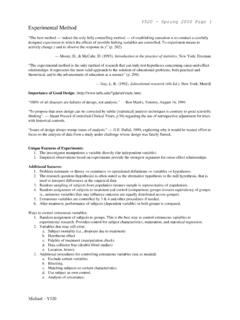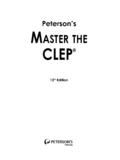Transcription of Close Reading Instruction - rhsdashboard.weebly.com
1 Close Reading Instruction Close Reading is analytical Reading Reading closely to determine what the text says explicitly and to make logical inferences from it. Close Reading requires re- Reading , because challenging texts do not give up their meanings easily. A rich text simply cannot be understood and appreciated by a single read, no matter how skilled and motivated the reader. Instruction consists of: Modeling thinking during Close Reading . Requiring rereading, having students expand their purpose for each repeated read. Having students annotate as they read. Asking text-dependent questions: those that can only be answered by referring explicitly back to the text. These questions require evidence from the text and not from the student's own knowledge of the subject, which can be difficult to filter out. Choosing passages to use for Close readings: Choose a short, worthy passage between 3-9 paragraphs to allow students to practice. Select a text that's complex -either quantitatively (at a higher readability level), qualitatively (how language is used or knowledge demands placed on students), or complex based on your purposes.
2 Select a text more challenging than texts students encounter during other literacy activities. Your text- dependent questions should require students to think more deeply each time they reread this text. Guiding through Reading and rereading: 1. First Reading : key ideas and details. a. Have students identify the topic and main ideas. b. Have them state the main idea in 1-2 sentences. c. Then locate the phrases or sentences that led them to that. d. Ask literal-level questions of their general understanding and focus on key details so students grasp the main idea. What information in the text lets you know this is the main idea?". 2. Second Reading : Craft and structure. Moving from identifying facts and details to a conclusion or interpretation. a. Foster deeper thinking by focusing on key vocabulary, organization of the passages, and author's purpose. 3rd Reading b. Have students identify the tone created by the words. c. Ask a text-dependent question to set a purpose for this Reading , then have students discuss with 2nd Reading partners.
3 D. Have the entire class share-out to assess understanding. 1st Reading 3. Third Reading : Ask questions about the author's opinions and arguments. a. Ask for specific passages as evidence for support. "What would logically happen next? What clues support your thinking? Do you agree/disagree with the author? Provide evidence for your answers.". b. Have students record ideas on sticky notes or a graphic organizer, or journal a response to a text-dependent question. Annotating Teach students to read with a pencil and annotate as they read during all readings. The goal is for them to identify text clues, easily summarize the text, and identify any areas of confusion. It keeps students actively thinking as they read and express it in writing and helps students to remember key points. Common symbols include: Underline main points. Circle key words or phrases. Circle words that are confusing or unknown in red. Put a question mark near things you wonder about and write your question.
4 Highlight multiple sentences. Put exclamation points near things that interest or surprises you, reminds you of something, or really understand it. Underline words that indicate what the author is feeling about it. Star important information. Draw an arrow when you make a connection. Write EX for examples. Number arguments or details in sequence. Chunk the Text 1. Have students combine paragraphs of similar content as they read and label each chunk in the left margin. 2. Write questions in the right margin. What is the author saying? Why is this important? Does this make sense? Why ? Who is ? Providing Accomodations for Close Reading Model a think-aloud: read the text to the Highlight context clues in the passage. students and modeling your thinking as you Pre-teach any helpful background knowledge. answer a text dependent question. Provide realia or visual glossaries. Provide students with copies of a text dependent question in advance of Reading . The Redesigned SAT: Teacher Implementation Guide Excerpted from Skill-Building Strategies for Reading : Students may be unaccustomed to the length and challenge of Reading Test passages.
5 Assign a range of Reading passages that includes some longer and more difficult selections, and provide students with needed scaffolding and support so that they can develop the needed independence in Reading such pieces. To help students recognize how an author's selection of words and phrases shapes meaning, style, and tone, ask them to select a particularly meaningful or powerful word or phrase from a Reading selection and substitute for it another word or phrase of similar meaning. Discuss how it is uncommon for two words or phrases to have exactly the same impact, nuance, or connotation even when they have similar dictionary definitions. When Reading literature passages, primary sources, or current event publications, ask students to use the SOAPSTone method to analyze the text. Ask students to identify the Speaker, Occasion, Audience, Purpose, Subject, and Tone. Students can deepen their understanding of both content and meaning by comparing these elements across several documents focused on a similar theme or topic.
6 Ask students to write questions that investigate understanding of a lesson or unit. Questions should be at various levels: literal, interpretive, and universal questions that prompt deeper thinking. Students will practice identifying meaningful and relevant information in order to create high-quality questions for their peers to answer. When students answer their peers' questions, require them to provide the evidence that supports their selection. Ask students to identify similarities and differences in multiple passages. Have them create a Venn diagram or develop their own graphic organizers to organize their thoughts and facilitate synthesis and analysis of multiple texts. Visual representations can also be used to trace other kinds of relationships, such as sequence and cause- effect. Ask students to locate and present additional texts that support an author's conclusion and to defend their choices by citing textual evidence ( , quotations) from the additional texts. This allows students to practice both synthesizing and supporting their ideas with evidence.






